Blogs
Dive Indonesia Part 2: Raja Ampat Trip Report
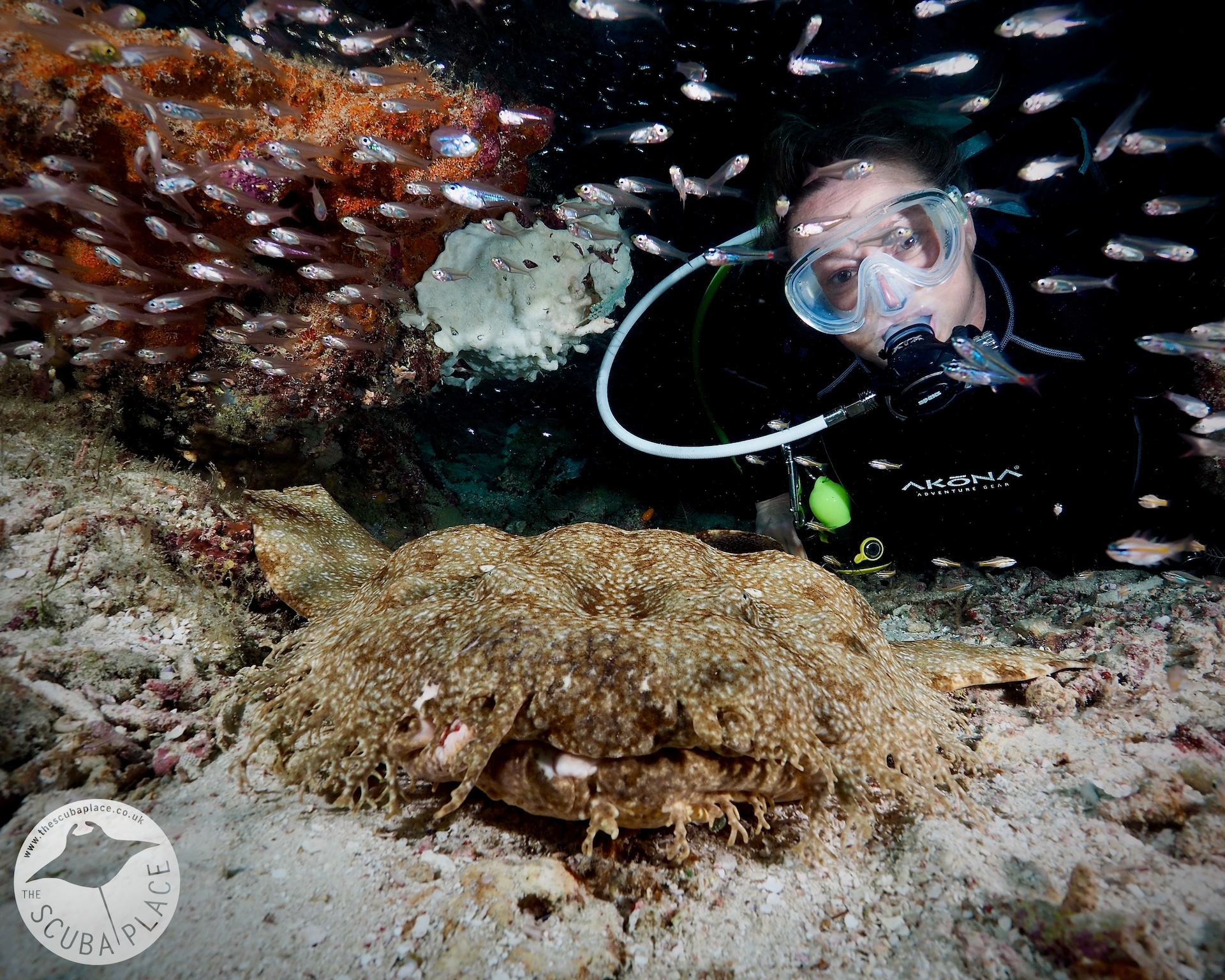
This January The Scuba Place visited Ambon, Raja Ampat and Lembeh hosting agroup of divers. They stayed at some amazing spots and saw some amazing things. This is their trip report on their second stop in Raja Ampat.
Raja Ampat has always been on our bucket list – just like pretty much every other diver on the planet! We just had to go, and so the choice of liveaboard or resort was the only difficult one we had to make! We chose the latter and opted to stay at the enticing Dive into Raja Ampat.
This was, for some of our group, our second week in Indonesia, and we flew into Sorong from Ambon. Our other guests flew into Jakarta the night before, and flew on to Sorong in the early hours, catching the early ferry to Raja. Landing in Sorong, after walking across the tarmac and collecting our bags, we piled ourselves into the waiting SUVs and made the 20-minute trip to the port to catch the inter-island ferry.
It’s hot, loud, humid, busy, and seemingly disorganised chaos, but it works – welcome to the islands of Indonesia! Our drivers, provided by the resort, arranged for porters to take all our bags onto the ferry. We were shepherded upstairs into the VIP Cabin where the air-conditioning was very welcome. We checked every bag was present and got ready to relax for the two-hour crossing to our island resort. These are big and fast ferries, and they are super-stable, so we weren’t troubled by any seasickness, and a simple range of snacks (biscuits, crisps, and a local version of a pot noodle) and cold soft drinks were available from a small café on board. It seemed as though time flew, and we arrived into the port of Waisai on Waigeo, Raja Ampat’s largest island.
Disembarking was again an experience, but the resort staff were there to collect us and our bags, popping us into waiting SUVs and whisking us off to the resort – a mere 15 minutes away through some stunning scenery.
We arrived and were greeted with a cold drink, and a cold flannel, and welcomed to the resort. Our bags were taken to our rooms whilst we sat and chilled for a bit, and after a shower and a change, we were given a resort and dive briefing.
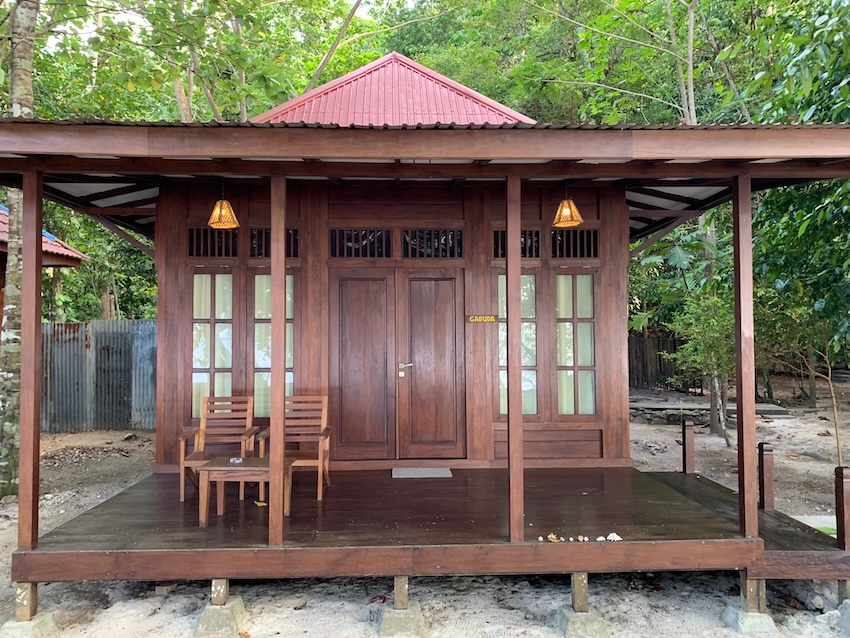
The resort, made up of 14 rooms, a restaurant, and the dive centre, sits underneath the jungle canopy and on a white sandy beach. There are three room categories – Garden terrace rooms, Seaview rooms, and Waterfront villas. The rooms are super comfortable, with effective air conditioning, vaulted ceilings with fans, a deck or terrace with furniture, en-suite shower rooms and an outdoor shower tap to rinse off. Each room also has its own water dispenser providing both hot and cold drinking water. The Seaview rooms and Waterfront villas have spectacular views, and the Garden terrace rooms have partial sea views too. More Waterfront villas are planned, and they really are on the waterfront – the sea comes right up the beach to the deck at high tide!
The restaurant offers water, tea, and coffee all day, and breakfast starts early for those who get up with the beautiful sunrises. Eggs and omelettes to order, plus fruit, cereals, toast, and a selection of hot offerings, both local and western, set you up well for the day. Lunch and dinner are again buffet style – a superb homemade soup, fresh slices of bread and then both Western and Indonesian main dishes, served with rice, noodles or potatoes. Fruit makes up the dessert at lunchtime, and a proper pud is offered at dinner. An afternoon snack is a welcome treat after the afternoon dive – expect cakes and pastries and all things non-diet related! Special dietary needs can be catered for if pre-advised.
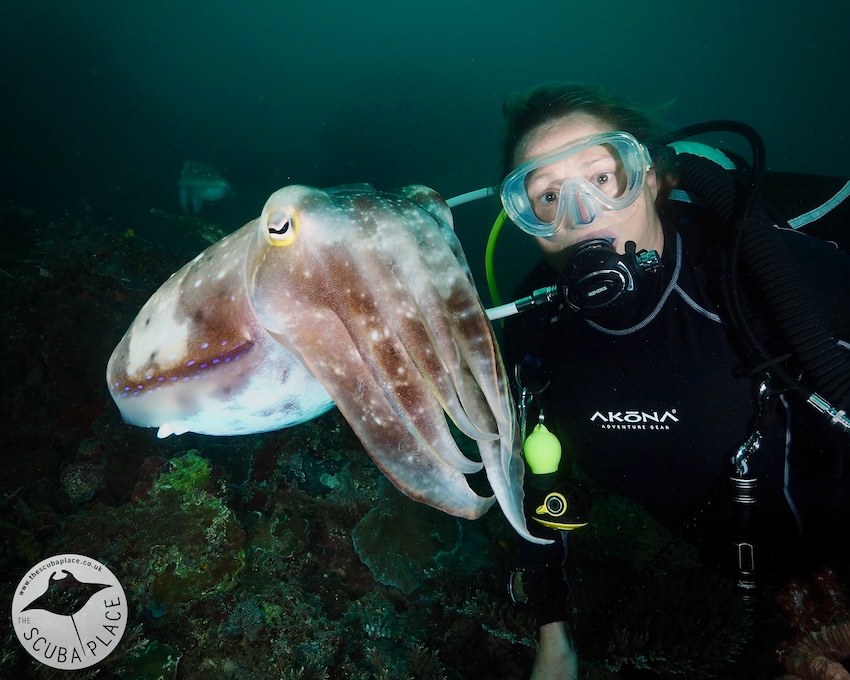
The bar sits right alongside the restaurant and faces the sea – a great place to grab an ice-cold beer, wine from the small but decent wine list or a cocktail We sampled a few of these, in the pursuit of accurate research of course, and they hit the spot!
The resort fringes the jungle canopy, and it is just beautiful. Look up, and there is green everywhere – and birds of paradise, butterflies, geckos, and the cuscus bear – a sloth-like member of the marsupial family that clambers with great dexterity and no haste in the trees around the resort. Ask any member of staff and they will point to one without hesitation – which will save craning your neck for ages while you look for them with untrained eyes!
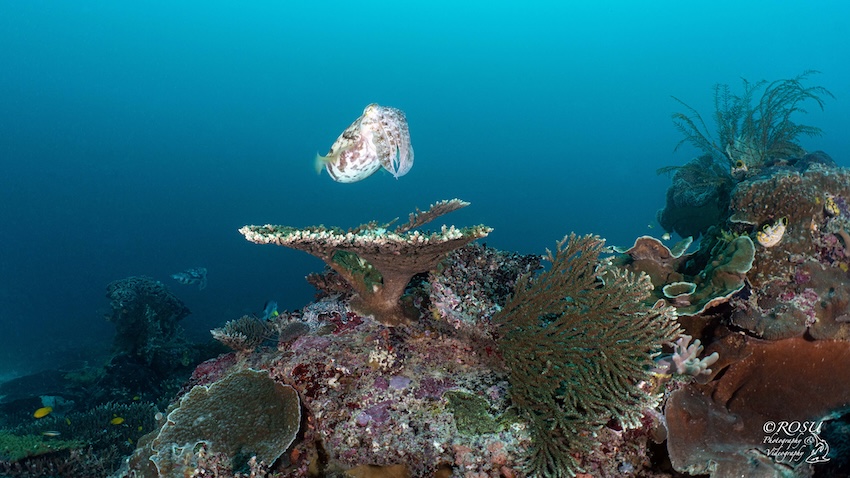
The dive centre is right on site, and the jetty to take you to the dive boats is a minute’s walk along the beachfront. The recently re-built dive centre has individual hanging spaces for each diver, rinse tanks behind and a superb camera room with separate rinse tanks, air guns and individual charging and assembly desks right next. Locked at night, the camera room opens at 6 am and closes at 10 pm, giving ample time to get in and organise yourselves! Nitrox, 15-litre tanks and even DPVs plus a whole range of equipment are available right on site.
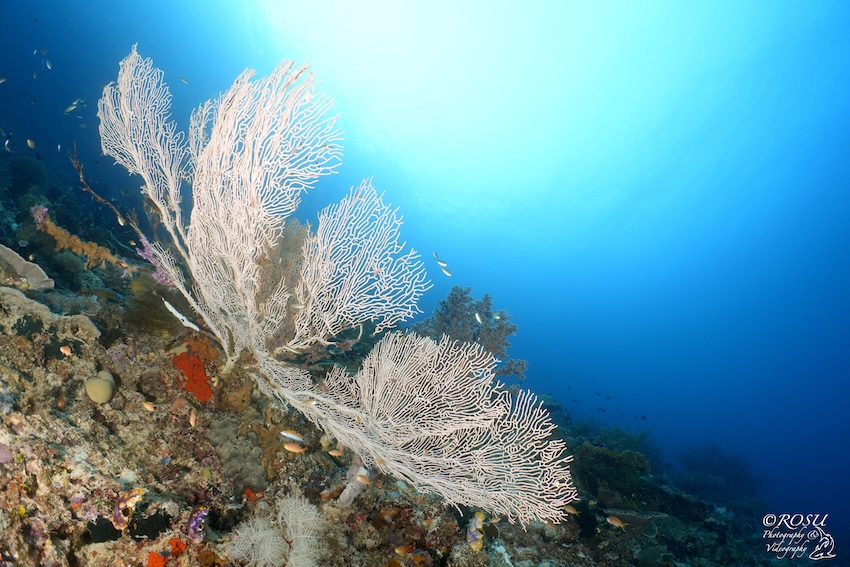
The normal dive day comprises of a two-tank boat trip in the morning and a single-tank boat trip in the afternoon. The house reef is open all day! There are a couple of longer day trips with three dives and lunch on board the dive boats, and these are not to be missed. We took a trip to the famous viewpoint at Piaynemo and the manta cleaning stations, for both oceanic and reef mantas and these excursions should be on every visitor’s dive plans.
And the diving? Huge – that is the only word that I can use to describe the underwater world in Raja Ampat. Huge corals. Huge schools of fish. Huge reefs. Huge list of marine life encountered. And huge currents from time to time too!
The resort is in the Dampier Strait, home to many of the dive sites on any Northern Raja safari itinerary, so we sped out to the best of the best dive sites each day. And a strait it is – a through route between islands that inevitably brings in currents and big tides moving nutrients through the waters, both of which are reasons why the reefs are so incredibly healthy
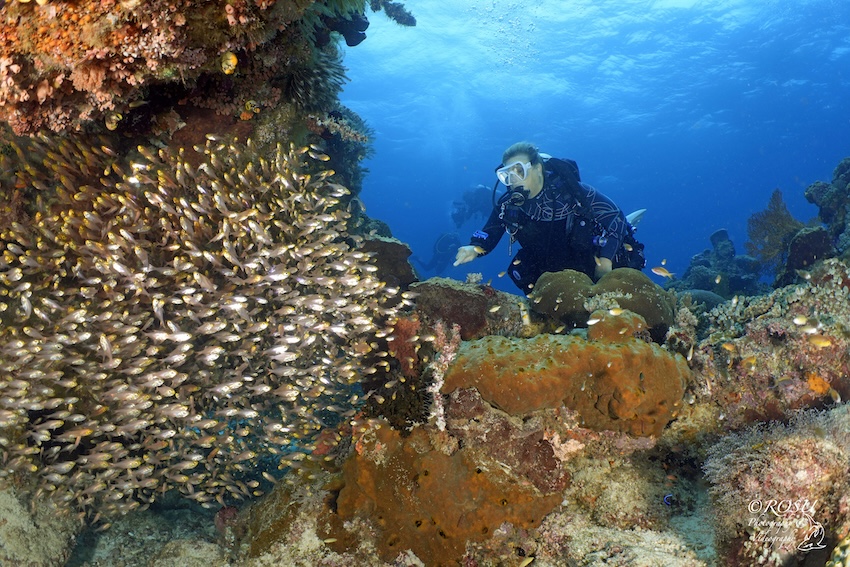
We saw mobula and eagle rays, barracuda, jacks, snapper, grunts, banner fish, batfish, tuna, billions of glassfish and sweepers, rainbow wrasse and so much more. Cuttlefish that were happy to interact, wobbegongs sleeping below overhangs, huge green and hawksbill turtles, octopus, signal gobies, and blennies galore. We found numerous types of clownfish in their multi-coloured anemones. Even some very very territorial ones who would defend their homes from about 5 metres away! Frogfish, ornate ghost pipefish, banded pipefish, porcelain crabs, squat lobsters – the list goes on and on – and then on some more!
Oh – and the manta rays! We saw both reef and oceanic mantas. And let’s not forget the sharks! Grey reef, black tip, and white tip reef sharks were seen on lots of our dives, and on some of the bigger current dives, we saw them in big numbers off the edge of the reef.
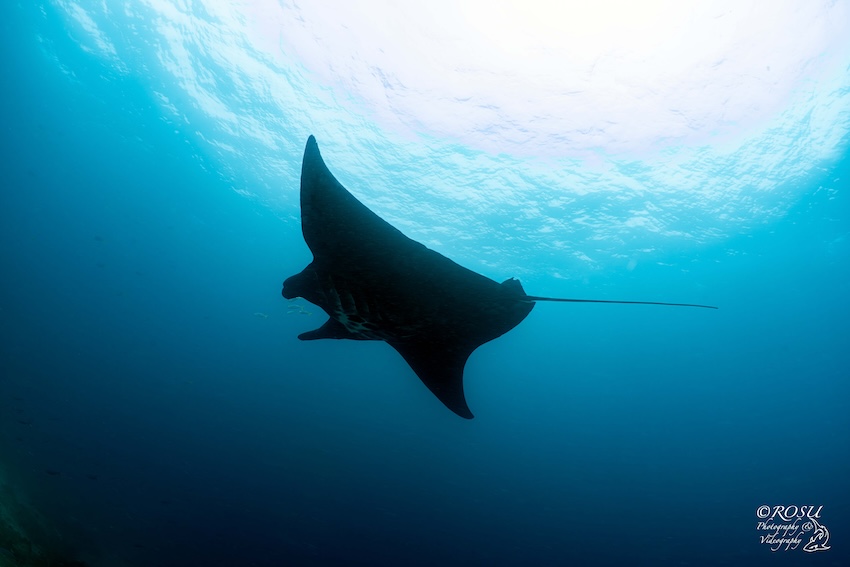
Special thanks to Rob and Susie for sharing some of their amazing photos from the trip.
Visibility varied from 20+m to less than 10m, depending on the dive site, current and tide, but whatever it was, there was loads to see. The corals are immense, and the reefs go on and on. Staghorn coral forests, gorgonian giants, whip coral jungles, stunning sponges everywhere – I have never experienced so much life underwater anywhere! The water temperature hovered around 29′ for every dive, but there were one or two thermoclines that brought on a shiver for a moment or two. Most of us wore 3mm full suits and didn’t have an issue maintaining core temperatures, and we did a lot of diving!
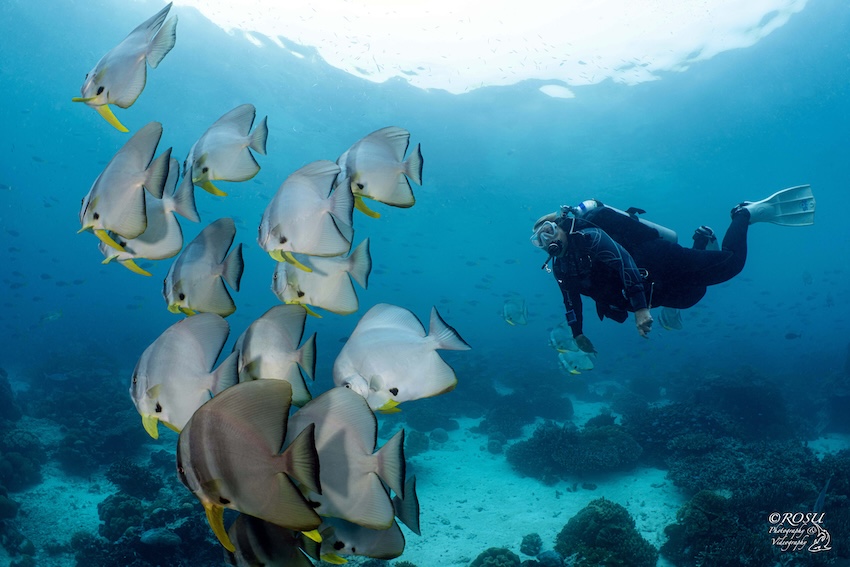
We did some gentle bimbles along the reef, some deliberate drift dives, and some hard-core dives into the current to get to points where the shark action was taking place, and we did a dive in the biggest current I have ever experienced! All the big drift dives previously experienced across the globe became like a kid’s slide in a soft play park compared to this one at Kri Island. We were simply grabbed by the current without any notice and launched at breakneck speed over the top of the reef, whipping past bommies and pillars, using our fins to steer between fans and a shiver of half a dozen reef sharks, we were eventually catapulted out into the blue at the end of the reef – what an experience!
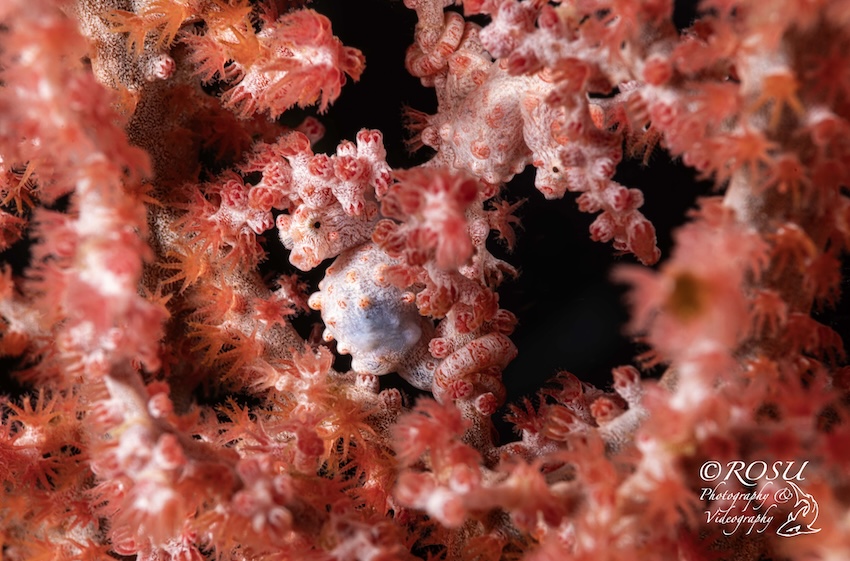
We did a couple of additional excursions in our week with Dive into Raja Ampat – a three-tank day trip to dive with the monitored populations of manta rays, and a three-tank day to take in the iconic views of Piaynemo.
The mantas are monitored by scientists, and there is an observation platform on top of the reefs where they visit a favourite cleaning station for the Oceanic mantas. Across the reef, we also dived on the lookout for reef mantas, and we had Lady Luck with us as they turned up! As we continued down the reef, a fever of at least 16 mobulas flew by in formation.
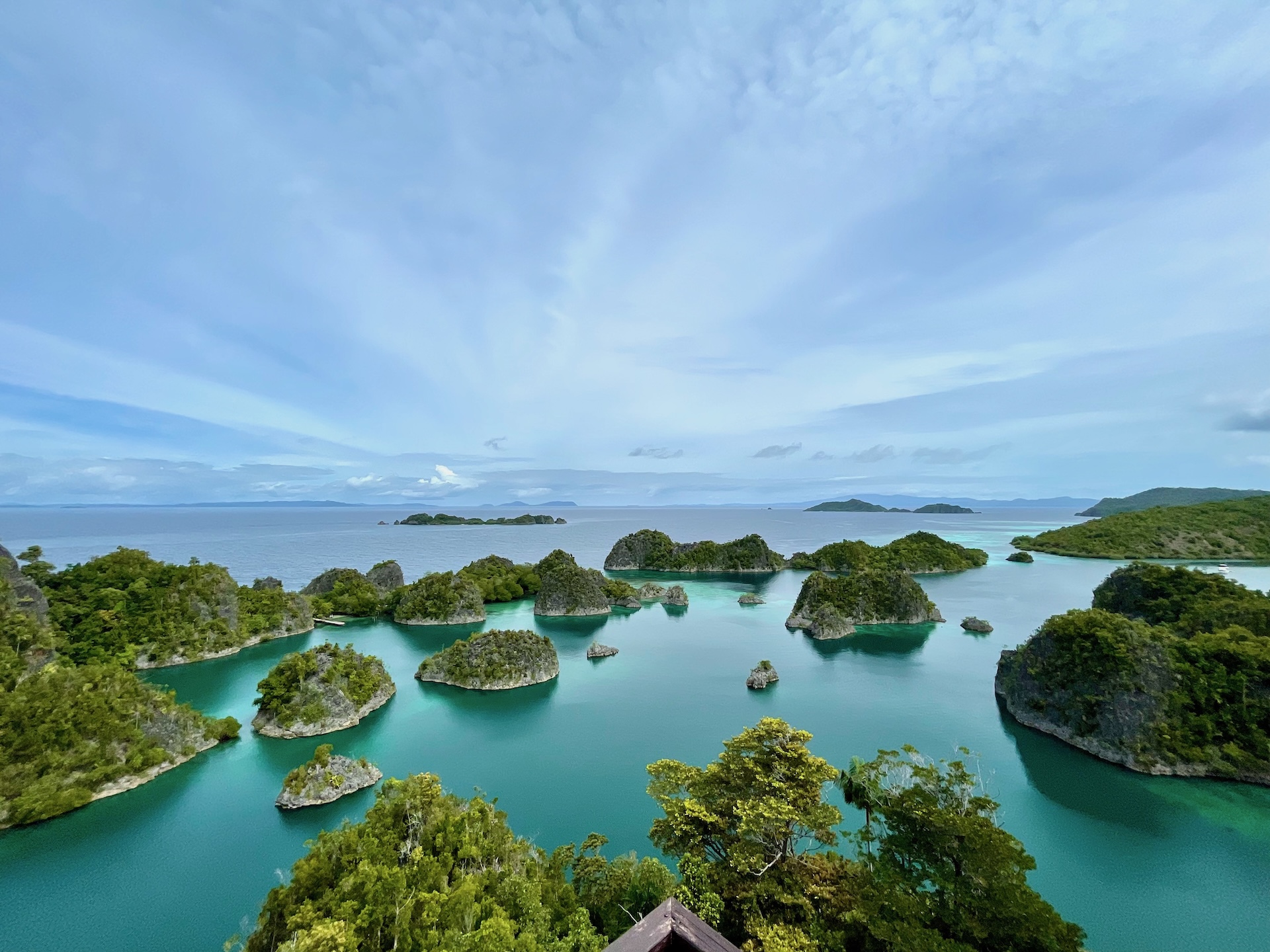
The trip to Piaynemo was great fun with two awesome dives, and then a big climb up the hill to the viewing platform. We had blue skies and captured that photo that is synonymous with being in Raja Ampat. A third dive on the way back home under a pier was excellent. It gave us a lovely backdrop for photography and was complete with turtles and curious batfish.
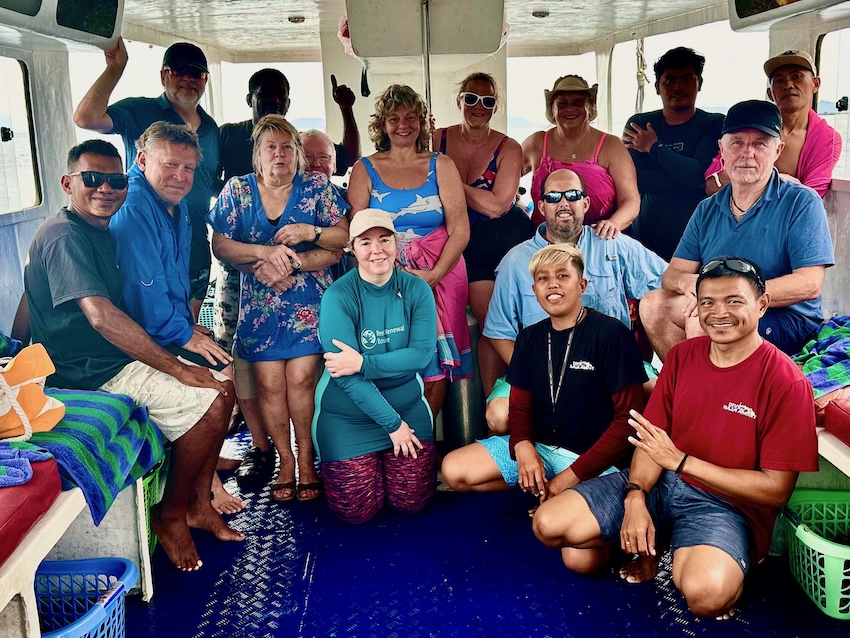
The dive staff were amazing for the whole week – they know their dive sites and found us all sorts, and they always kept an eye on us and ensured our safety. You can have thousands of dives in your logbook, but a different environment can be a real leveller, especially if there is a huge current or reduced visibility.
The dive boats are big, fast, and comfortable with a roof deck and an open bow area with seating if you wanted the sunshine, or a covered deck if you wanted to stay in the shade. A sea toilet on board made things easy and there was ample cold water, tea, and coffee, plus biscuits between dives! Backward rolls were our method of entry, and the ladder to get back into the boat was sturdy and easy, even for us with old bones and joints!
In one week, we dived most of the dive sites that a safari boat would do on the Northern Raja itinerary – we even tied up alongside one or two of them while our dive guides caught up with their friends on surface intervals! We love liveaboards, and there are some absolute stunners in Indonesia, but a week at Dive into Raja Ampat is exceptionally good value for money and considerably cheaper than a liveaboard, so we still can’t answer the opening question – Resort or Liveaboard?
We had a blast, loved the diving, loved the resort, and loved the whole experience – Raja delivered everything that we had anticipated, and more!
Key Facts:
- Getting there :We suggest flying with Emirates from Heathrow to Jakarta via Dubai. From Jakarta you can fly direct to Sorong on Garuda Indonesia. We prefer Garuda with their free 23kg dive equipment baggage policy and the flight is 4 hours. We were greeted at the airport and transported to the ferry port for our VIP crossing before a quick 15 minute transfer to the resort.
- Air temperature : Wageo in Raja Ampat enjoys a tropical rainforest climate – average daily temperature throughout the year is 29 to 31°C. The warmest and driest months are August and September and the wettest months are usually November and December
- Water temperature :An average of 30°C. A 1-3mm full suit or shorty will suit most.
- Visa requirement : We purchased our Visa on Arrival at the Jakarta airport for $35 USD (or 500,000 IDR) The visa is for an initial period of 30 days. Make sure you have pristine bank notes if paying in USD or exchange your GBP when you get to Indonesia. The bills must be unmarked and undamaged to be accepted. The Customs Declaration must be completed online and the provided QR code is shown to the Customs officers.
- Currency : Indonesian Rupiah(IDR) or US Dollar are accepted most places. We exchanged Sterling for Rupiah at the Jakarta airport for an attractive rate.
- Electricity :230V with European style (round pin) two-prong plugs. Our room and the camera room had extension leads with UK plugs so no adapter was needed.
- Internet and Wi-Fi : There is wifi in resort and worked well in our room. We were able to email, WhatsApp and post on social media without issue.
Price Guide: A week at Dive into Raja Ampat, including flights from the UK with baggage and transfers, on a 3 dive per day package including full board accommodation in a Garden terrace room, costs from £2599 per person, based on double occupancy. The bulk of the cost is the flights, so the cost of staying longer is surprisingly low! Extras: Indonesian Visa on Arrival, NITROX, soft drinks and adult beverages, and tips.
Our Advice: Indonesia is an amazing destination. Dive into Raja Ampat was the second top on our three-centre trip and the perfect stop for the big stuff in between our macro destinations of Ambon and Lembeh.
Packing tips :
- Rechargeable fan(s) :Perfect for warm planes, stuffy transfers and still evenings. We can’t believe we travelled without them for so many years! Join the fan club and grab one off Amazon… you won’t regret it!
- Travel laundry line : We find this comes in handy for any mid holiday hand washing and definitely at the end of the trip to hang SMBs, reels, dive socks etc.
- Insect repellent : We’ve made a habit of throwing some repellent in our dive bags every trip!
Sunscreen : Don’t forget to protect yourself when you’re in the sun and on the water!!
Come Dive with Us!
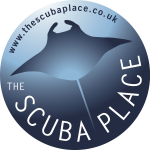 The Scuba Place designs and builds custom scuba diving holidays. With personal knowledge and experience diving in many of our destinations, there is no one better to help build your dream dive holiday. Come Dive with Us!
The Scuba Place designs and builds custom scuba diving holidays. With personal knowledge and experience diving in many of our destinations, there is no one better to help build your dream dive holiday. Come Dive with Us!
Call us at 020 3515 9955 or email at reservations@thescubaplace.co.uk
Find us at https://www.thescubaplace.co.uk
Facebook : https://www.facebook.com/thescubaplace
Instagram : https://www.instagram.com/the.scuba.place/
YouTube : https://www.youtube.com/channel/UCH684OdioYirI-zzdT58Ceg
Blogs
Alonissos: The complete diving destination (Part 1)

In June we were incredibly fortunate to be invited to dive in Alonissos, a small Greek Island in the Sporades island chain located in the North Aegean Sea. While I have long been a big fan of the Greek Islands as a great holiday destination, I had not had the opportunity to do any diving on previous visits and Mike and I were extremely excited to see what Alonissos had to offer both above and below the surface!

The Sporades are easily accessible via the airport in Skiathos (the first island in the chain), which is served by Jet2 flights from all major UK airports from May through October. Numerous ferries and charter boats make island hopping from Skiathos Town a breeze. After an hour boat ride, the picturesque port of Patitiri was a wonderful introduction to Alonissos, where we were met by our gracious hosts Kostas of Albedo Travel and Dias of Alonissos Triton Dive Center. Mike and I were delighted to be staying at the Paradise Hotel, aptly named for its stunning views over the sea and great location for walking to the waterfront.

Alonissos is beautifully situated in the National Marine Park of Alonissos and the Northern Sporades, the largest marine protected area in Europe. The surrounding seas offer fabulous marine life, including incredibly rare species such as the Mediterranean monk seal. They boast deep walls covered in gorgonians and sponges, stunning topography with caverns, swimthroughs and pinnacles, and the first accessible ancient shipwreck from 500BC!

In locations where historical sites have been reported, the waters are largely restricted, but with collaboration between government, underwater archeologists and dive centres, incredible underwater museums are being created for a truly unique diving experience. Alonissos is home to the first of these, the Ancient Shipwreck of Peristera Accessible Underwater Archeological Site. The chance to dive into history (along with reports of healthy reef life and amazing underwater topography) meant Mike and I were keen to get in the water.

Our introduction to the diving around Alonissos was at the Agios Georgios Pinnacles, in the channel between Alonissos and Skopelos. This fantastic site was named “The Chimney,’ and proved to have a huge amount to see. We got to a decent depth here (over 25m), and marvelled at a colourful reef wall with a wonderful swim through whose rocky walls were absolutely covered with life. As well as brilliant topography there was no shortage of macro life here. We saw numerous nudibranchs, five different species in total. The second dive at Mourtias reef nearby was a shallower dive along a nice wall with lots of crevices. Several moray eels and grouper called this site home. We enjoyed looking in the crevices for lobster and smaller benthic life, such as cup corals and tunicates.

Our itinerary allowed us two dives a day with afternoons left to explore the island with our hire car and evenings to enjoy the famous Greek hospitality. This proved to be a lovely mix of in-water and land based diversions.

The next days diving to the Gorgonian Gardens and Triton’s Cave was to be even better! These two stunning sites are nothing short of fabulous. The Gorgonian Gardens was a deep wall near to the Agios Georgios islands. The ever-present currents in this deep channel meant that the sea life was amazing … the namesake Gorgonian sea fans dotted the wall at a depth of 30 to 50 meters, getting ever larger the deeper we went. Above 30m was by no means less beautiful, with sponges, corals, scorpionfish, moray eels and some rare and colourful nudibranchs.

The second shallower dive of the day was to Triton’s Cave or the Cavern of Skopelos, on the east side of that island. The spectacular rock formations had wild striations both above and below the water making a truly epic topography. The cavern entrance was at 14m, and big enough for a buddy pair, winding up to 6m and passing two beautiful windows out into the blue. Emerging from the cavern, the light at the shallower depths and the incredible rock formations made for a fantastic gentle swimming safety stop and we all surfaced by the boat with massive grins.

Check out our next blog :Alonissos: The complete diving destination (Part 2)” to hear about our amazing dive on the 2500 year old Peristera Wreck!
Thanks to:
Alonissos Triton Dive Center https://bestdivingingreece.com/
Albedo Travel https://alonissosholidays.com/activities/
Paradise Hotel https://paradise-hotel.gr/
Alonissos Municipality https://alonissos.gr/en/
Blogs
Mamma Mia! Diving Skopelos (Part 2)

Our second days dive itinerary was to the famous Christoforos wreck! This is arguably the best dive in Skopelos and though only open to divers with deep diving experience, this 83m long wreck is well worth the visit.
The Christoforos sits in 43 meters of water with the deck at 32 to 35 meters. A 30m dive can give an impressive view of the wreck, though such a large wreck needs a few dives to truly do it justice. Given its ideal location just a 2 minute boat ride from the dive centre dock it is an excellent first dive of the day. The sheltered site is also diveable in all but the absolute worst weather so although deep, the water is usually clear with little to no current making it a very pleasant dive. The site is superb for technical diving and a great training site for the Tec 40 and 45 programs, offered by Skopelos Dive Center.

The Christoforos wreck was originally a collier ship built in 1950 at Grangemouth shipyard under the name “Thomas Hardie”. In 1976 she joined the Greek merchant fleet as “Christoforos”. On the 2nd of October 1983 the Christoforos was carrying 2600 tonnes of cement from Volos to Piraeus Port. During the voyage the weather turned, resulting in the ship developing a 7 degree list, whereby she changed course for safe anchorage at Panormos, Skopelos. The ship reached Panormos at 16:00 with a list of 17 degrees and water ingress to No. 1 hull. Though attempts were made to right the vessel, the crew were ordered to abandon ship at 22:00. The captain, lieutenant and the quartermaster remained to try and save the ship, but had to abandon the attempt themselves and the Christoforos finally sank at 05:30 on 3rd October 1983. She now sits upright in 43 meters of water less than 200m from shore in Panormos.

Diving has only been allowed here since 2018, so the wreck is very well preserved and a real treat to dive. Permission to dive here was granted by the authorities after lots of incredibly hard work by the Skopelos Dive Center staff. Having a fantastic wreck in such an amazing location and in excellent condition is a real privilege.

Of all the sites in Skopelos this was the site Mike and I were most keen to experience. Having kitted up and zipped across the bay to the mooring, we left the surface and followed the descent line until the wreck emerged spectacularly from the blue at 15m. She is a big and beautiful wreck, sitting as though calmly continuing her journey along the seabed. With most of her original features still intact there were points of interest everywhere, including the anchors, winches, ships telegraphs, the wheel and RDF antenna.

We found that aquatic life had colonised the ship, with schools of fish, electric blue nudibranchs, a large moray eel and the resident scorpionfish lurking inside the bridge. The Christoforos was truly a stunning wreck and despite maximising our time at depth we eventually had to say our goodbyes and begin the slow and steady return to the surface.

After a superb morning dive we had the afternoon to do a little sightseeing of the island, with a trip to the church of Agios Ioannis Kastri made famous by the blockbuster movie “Mamma Mia!”. Mike and I spent a happy afternoon pootling around in our little hire car before meeting up with Lina from Skopelos Dive Center. An underwater archeologist as well as a dive professional, Lina had offered to show us a rather special attraction, the Christoforos shipwreck Digital Spot public information and awareness centre.

A fantastic initiative made possible from the collaboration of the government and hard work of the staff at Skopelos Dive Center is the “Digital Spot” in Agnontas port. This information center has a number of displays on the history of the Christoforos wreck, the process by which the wreck was allowed to be opened to the public for diving tourism, other sites of historical interest in the area, a video of the wreck and the best bit, a virtual reality dry dive experience! The beauty of the VR system is that non diving members of the family can see what you have seen on the wreck, or you can see areas that you may not have explored during the dive due to time or depth limitations. It was a truly immersive experience and a great addition to the dive itself.

After a wonderful day we celebrated our last evening on the island with an exquisite meal in Skopelos Town with fabulous views over the town and bay, washed down with the excellent local wine. The lamb with lemon and potatoes was a meal which I could happily eat every day for the rest of my life!

Skopelos is an island that truly has it all. The diving is excellent, the landscape is beautiful with plenty of non diving activities, the locals friendly and the food and drink superb. Given how accessible it is as a holiday destination it has avoided becoming overcrowded and even in peak season offers a fun yet relaxing atmosphere. We highly recommend giving Skopelos a visit. We will certainly be back again!
Thanks to:
Municipality of Skopelos (https://skopelos.com/)
Skopelos Dive Center (https://sporadesdiving.gr/)
Ionia Hotel (https://www.ioniahotel.gr/en)
Dolphin of Skopelos (https://dolphinofskopelos.com/)
Ta Kymata restaurant (@takymata)
The Muses restaurant (https://www.facebook.com/TheMussesMousses/)
Aktaiov resturant (https://skopelos.com/listings/aktaion-taverna/)
-

 Blogs2 months ago
Blogs2 months agoDiving With… Nico, Ocean Earth Travels, Indonesia
-

 News1 month ago
News1 month agoMurex Bangka Announce New Oceanfront Cottages & Beachfront Dining
-

 Blogs2 months ago
Blogs2 months agoA new idea in freediving from RAID
-

 Marine Life & Conservation1 month ago
Marine Life & Conservation1 month agoIceland issue millionaire whale hunter a licence to murder 128 vulnerable fin whales
-

 Marine Life & Conservation2 months ago
Marine Life & Conservation2 months agoThe Shark Trust Great Shark Snapshot is back
-
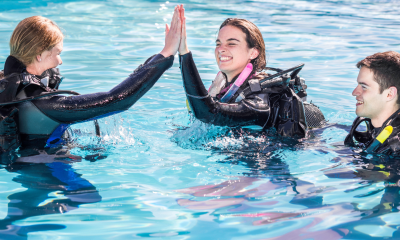
 News3 months ago
News3 months agoCharting New Waters; NovoScuba Goes Global with the Launch of their Revolutionary Dive Training Agency!
-

 Gear News1 month ago
Gear News1 month agoNew Suunto Ocean – a dive computer and GPS sports watch in one for adventures below and above the surface
-

 Marine Life & Conservation Blogs2 months ago
Marine Life & Conservation Blogs2 months agoBook Review: Plankton















